Page 330 of 486
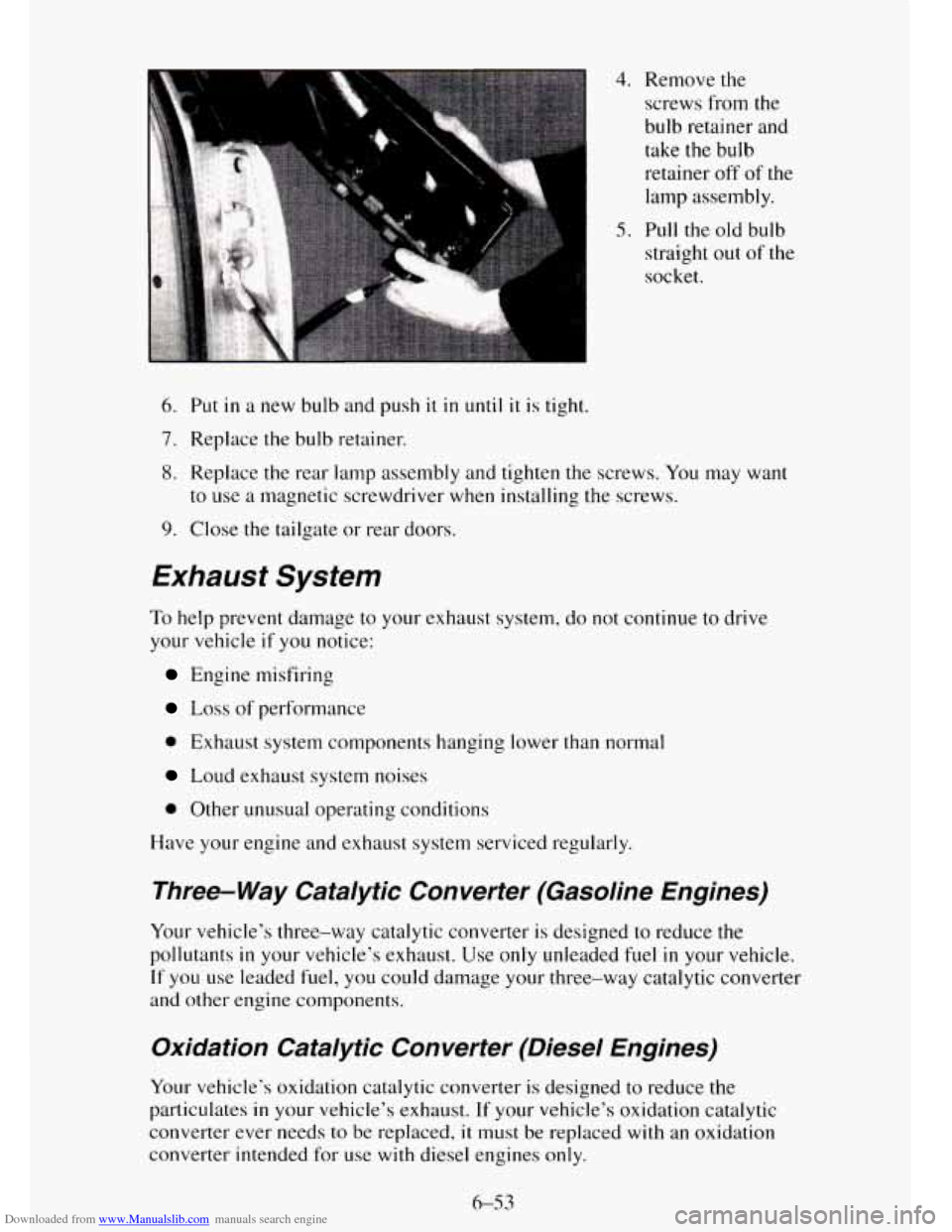
Downloaded from www.Manualslib.com manuals search engine 4. Remove the screws from the
bulb retainer and take the bulb
retainer off
of the
lamp assembly.
straight out of the
socket
.
5. Pull the old bulb
6. Put in a new bulb and push it in until it is tight.
7. Replace the bulb retainer.
8. Replace the rear lamp assembly and tighten the screws. You may want
to use a magnetic screwdriver when installing the screws.
9. Close the tailgate or rear doors.
Exhaust System
To help prevent damage to your exhaust system, do not continue to drive
your vehicle
if you notice:
Engine misfiring
Loss of performance
0 Exhaust system components hanging lower than normal
Loud exhaust system noises
0 Other unusual operating conditions
Have your engine and exhaust system serviced regularly.
Three- Way Catalytic Converter (Gasoline Engines)
Your vehicle’s three-way catalytic converter is designed to reduce the
pollutants
in your vehicle’s exhaust. Use only unleaded fuel in your vehicle.
If you use leaded fuel, you could damage your three-way catalytic converter
and other engine components.
Oxidation Catalytic Converter (Diesel Engines)
Your vehicle’s oxidation catalytic converter is designed to reduce the
particulates
in your vehicle’s exhaust. If your vehicle’s oxidation catalytic
converter ever needs to be replaced,
it must be replaced with an oxidation
converter intended for use
with diesel engines only.
6-53
Page 331 of 486
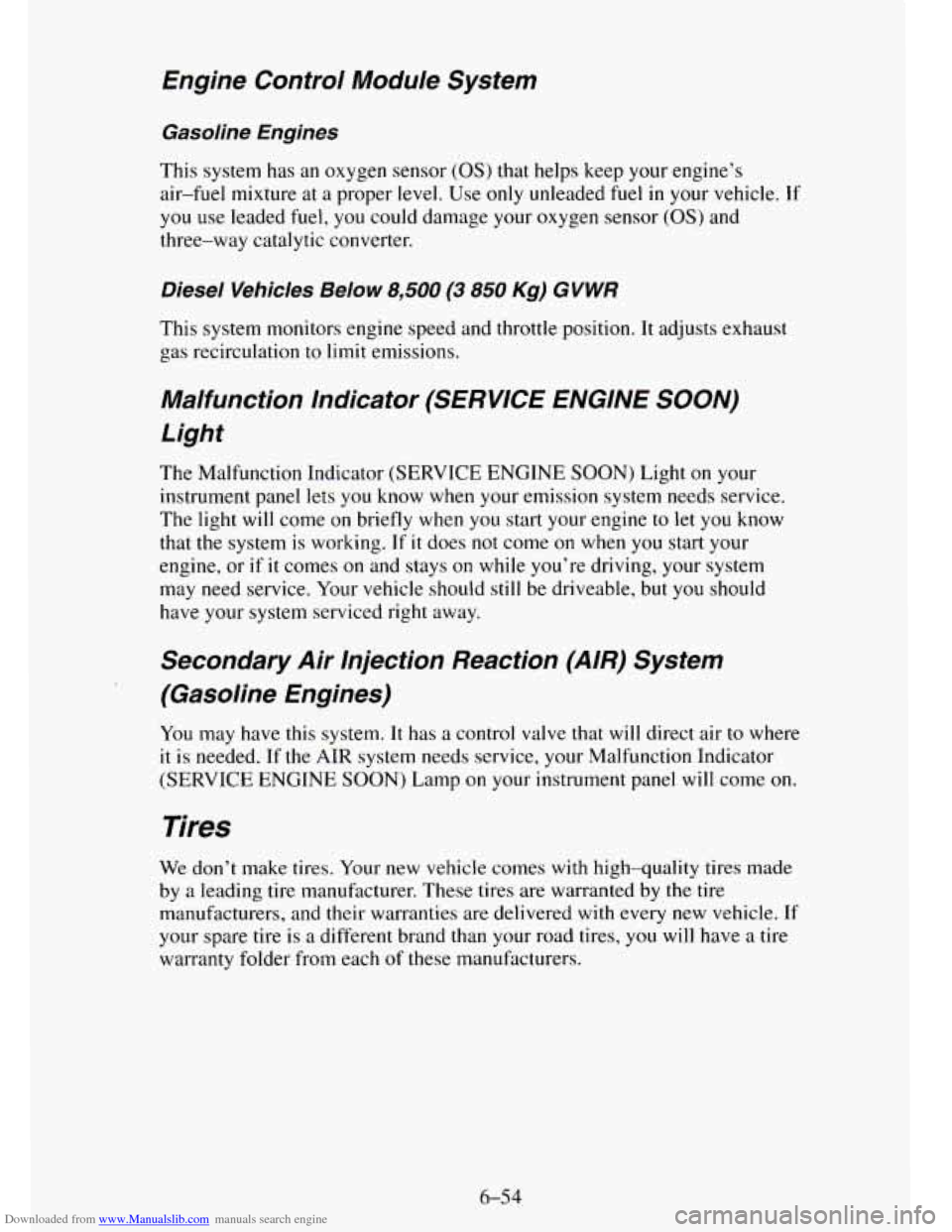
Downloaded from www.Manualslib.com manuals search engine Engine Control Module System
Gasoline Engines
This system has an oxygen sensor (OS) that helps keep your engine’s
air-fuel mixture at a proper
level. Use only unleaded fuel in your vehicle. If
you use leaded fuel, you could damage your oxygen sensor (OS) and
three-way catalytic converter.
Diesel Vehicles Below 8,500 (3 850 Kg) GVWR
This system monitors engine speed and throttle position. It adjusts exhaust
gas recirculation to limit emissions.
Malfunction Indicator (SERVICE ENGINE SOON)
Light
The Malfunction Indicator (SERVICE ENGINE SOON) Light on your
instrument panel lets you know when your emission system needs service.
The light will come on briefly
when you start your engine to let you know
that the system is working.
If it does not come on when you start your
engine, or if
it comes on and stays on while you’re driving, your system
may need service. Your vehicle should still be driveable, but
you should
have your system serviced right away.
Secondary Air Injection Reaction (AIR) System
(Gasoline Engines)
You may have this system. It has a control valve that will direct air to where
it is needed. If the AIR system needs service, your Malfunction Indicator
(SERVICE ENGINE
SOON) Lamp on your instrument panel will come on.
Tires
We don’t make tires. Your new vehicle comes with high-quality tires made
by
a leading tire manufacturer. These tires are warranted by the tire
manufacturers, and their warranties are delivered with every new vehicle.
If
your spare tire is a different brand than your road tires, you will have a tire
warranty folder from each
of these manufacturers.
6-54
Page 334 of 486
Downloaded from www.Manualslib.com manuals search engine The purpose of regular rotation is to achieve more uniform wear for all tires
on the vehicle. The first rotation
is the most important. See “Scheduled
Maintenance Services”
in the Index for scheduled rotation intervals.
FRT FRT
When rotating your
tires, always use the
correct rotation
pattern shown here.
When rotating your
tires,
always use one
of the correct rotation
patterns shown here.
After the tires have been rotated, adjust the front and rear inflation pressures
as shown
on the CertificatiodTire label. Make certain that all wheel nuts are
properly tightened.
See “Wheel Nut Torque” in the Index.
6-57
Page 335 of 486
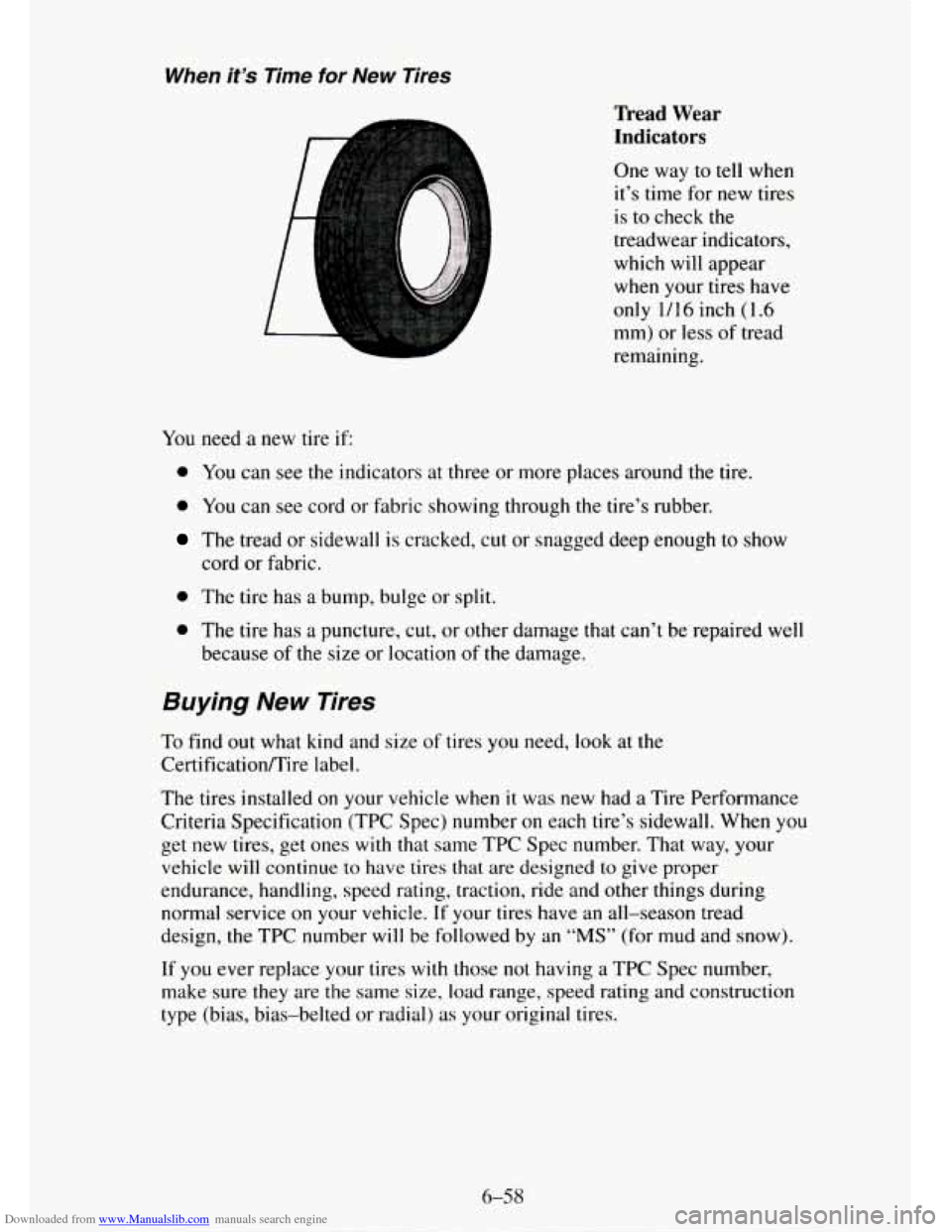
Downloaded from www.Manualslib.com manuals search engine When it’s Time for New Tires
Tread Wear
Indicators
One way to tell when
it’s time for new tires
is to check the
treadwear indicators,
which will appear
when your tires have
only
1/16 inch (1.6
mm) or less of tread
remaining.
You need a new tire if
0 You can see the indicators at three or more places around the tire.
e You can see cord or fidbric showing through the tire’s rubber.
The tread or sidewall is cracked, cut or snagged deep enough to show
cord
or fabric.
0 The tire has a bump, bulge or split.
0 The tire has a puncture, cut, or other damage that can’t be repaired well
because of the size or location
of the damage.
Buying New Tires
To find out what kind and size of tires you need, look at the
Certification/Tire label.
The tires installed
on your vehicle when it was new had a Tire Performance
Criteria Specification (TPC Spec) number on each tire’s sidewall. When you
get new tires, get ones with that same TPC Spec number. That way, your
vehicle will
continue to have tires that are designed to give proper
endurance, handling, speed rating, traction, ride and other things during
normal service
on your vehicle. If your tires have an all-season tread
design, the TPC number
will be followed by an “MS” (for mud and snow).
If
you ever replace your tires with those not having a TPC Spec number,
make sure
they are the same size, load range, speed rating and construction
type (bias, bias-belted or radial)
as your original tires.
Page 336 of 486
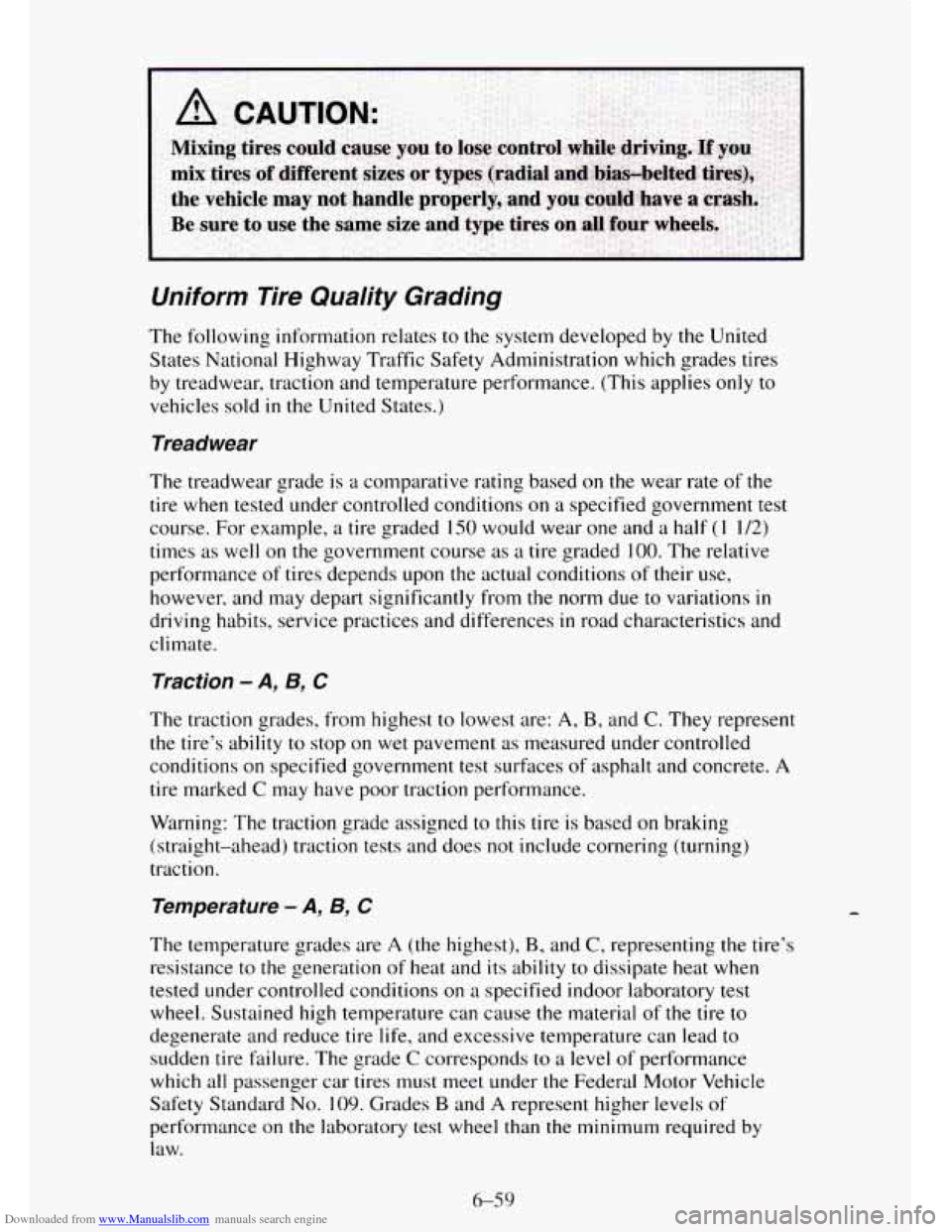
Downloaded from www.Manualslib.com manuals search engine Uniform lire Qualify Grading
The following information relates to the system developed by the United
States National Highway Traffic Safety Administration which grades tires
by treadwear, traction and temperature performance. (This applies
only to
vehicles sold in the United States.)
Treadwear
The treadwear grade is a comparative rating based on the wear rate of the
tire when tested under controlled conditions on a specified government test
course. For example, a tire graded 150 would wear one and a half
(I 1/2)
times as well on the government course as a tire graded 100. The relative
performance of tires depends upon the actual conditions
of their use,
however, and may depart significantly from the norm due to variations
in
driving habits, service practices and differences in road characteristics and
climate.
Traction - A, B, C
The traction grades. from highest to lowest are: A, B, and C. They represent
the tire’s ability to stop on wet pavement as measured under controlled
conditions on specified government test surfaces
of asphalt and concrete. A
tire marked
C may have poor traction performance.
Warning:
The traction grade assigned to this tire is based on braking
(straight-ahead) traction tests and does not include cornering (turning)
traction.
Temperature - A, 6, C
The temperature grades are A (the highest), B, and C, representing the tire’s
resistance to the generation
of heat and its ability to dissipate heat when
tested under controlled conditions on
a specified indoor laboratory test
wheel. Sustained high temperature can cause
the material of the tire to
degenerate and reduce
tire life, and excessive temperature can lead to
sudden tire fdilure. The grade
C corresponds to a level of performance
which all passenger car tires must meet under the Federal Motor Vehicle
Safety Standard
No. 109. Grades B and A represent higher levels of
performance on the laboratory test wheel than the minimum required
by
law.
6-59
--
Page 347 of 486
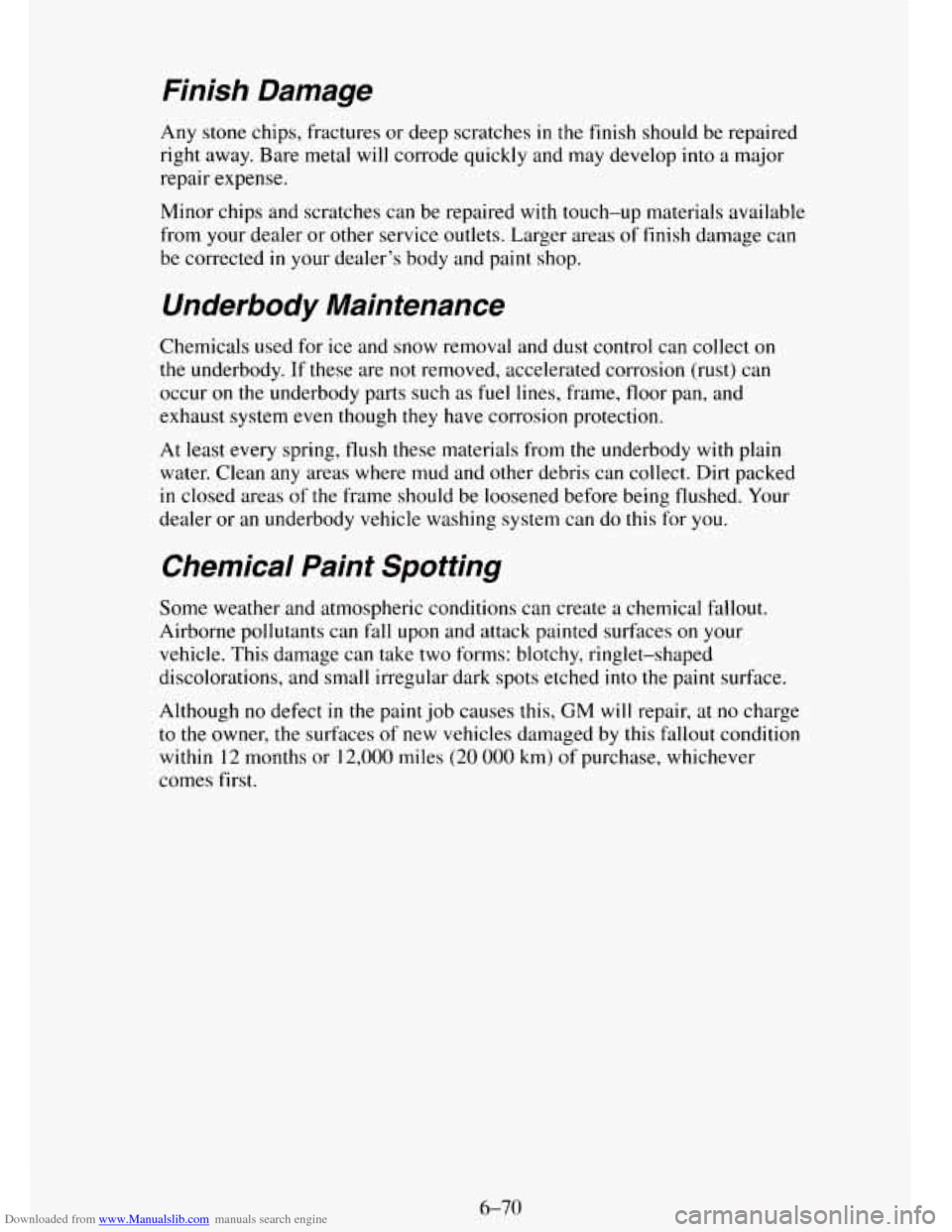
Downloaded from www.Manualslib.com manuals search engine Finish Damage
Any stone chips, fractures or deep scratches in the finish should be repaired
right away. Bare metal will corrode quickly and may develop
into a major
repair expense.
Minor chips and scratches can be repaired
with touch-up materials available
from your dealer
or other service outlets. Larger areas of finish damage can
be corrected
in your dealer’s body and paint shop.
Underbody Maintenance
Chemicals used for ice and snow removal and dust control can collect on
the underbody. If these are not removed, accelerated corrosion (rust) can
occur
on the underbody parts such as fuel lines, frame, floor pan, and
exhaust system even though
they have corrosion protection.
At least every spring, flush these materials from the underbody with plain
water. Clean any areas where mud and other debris can collect. Dirt packed
in closed areas of the frame should be loosened before being flushed. Your
dealer or an underbody vehicle washing system can do this for
you.
Chemical Paint Spotting
Some weather and atmospheric conditions can create a chemical Fallout.
Airborne pollutants can fall upon and attack painted surfaces on your
vehicle. This damage can take two forms: blotchy, ringlet-shaped
discolorations, and small irregular dark spots etched
into the paint surface.
Although no defect
in the paint job causes this, GM will repair, at no charge
to the owner, the surfaces of new vehicles damaged by this fallout condition
within
12 months or 12,000 miles (20 000 km) of purchase, whichever
comes first.
6-70
Page 349 of 486
Downloaded from www.Manualslib.com manuals search engine Vehicle Identification Number (VIN)
This is the legal identifier for your vehicle. It appears on a plate in the front
corner
of the instrument panel, on the driver’s side. You can see it if you
look through the windshield from outside your vehicle. The VIN also
appears
on the Vehicle Certification and Service Parts labels and the
certificates of title and registration.
Engine Identification
The eighth character in your VIN is the engine code. This code will help
you identify your engine, specifications, and replacement parts.
6-72
Page 351 of 486
Downloaded from www.Manualslib.com manuals search engine Service Parts Identification Label
You’ll find this label on the inside of the glove box.
Tt’s very helpful if you ever need
to order parts. On this label is:
your VIN,
the model designation,
paint information, and
0 a list of all production options and special equipment.
Be sure
that this label is not removed from the vehicle.
Add-on Electrical Equipment
I NOTICE:
Don’t add anything electrical to your vehicle unless you che\
ck
with your dealer first. Some electrical equipment can damage
your vehicle and the damage wouldn’t be covered by your
warranty. Some add-on electrical equipment can keep other
components from working as they should.
Your vehicle has an air bag system. Before attempting to add anything
electrical to your vehicle,
see “Servicing Your Air Bag-Equipped Vehicle”
in the Index.
6-74